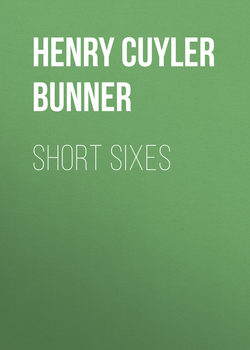Читать книгу Short Sixes - Bunner Henry Cuyler - Страница 4
THE TWO CHURCHES OF ’QUAWKET
ОглавлениеThe Reverend Colton M. Pursly, of Aquawket, (commonly pronounced ’Quawket,) looked out of his study window over a remarkably pretty New England prospect, stroked his thin, grayish side-whiskers, and sighed deeply. He was a pale, sober, ill-dressed Congregationalist minister of forty-two or three. He had eyes of willow-pattern blue, a large nose, and a large mouth, with a smile of forced amiability in the corners. He was amiable, perfectly amiable and innocuous – but that smile sometimes made people with a strong sense of humor want to kill him. The smile lingered even while he sighed.
Mr. Pursly’s house was set upon a hill, although it was a modest abode. From his window he looked down one of those splendid streets that are the pride and glory of old towns in New England – a street fifty yards wide, arched with grand Gothic elms, bordered with houses of pale yellow and white, some in the homelike, simple yet dignified colonial style, some with great Doric porticos at the street end. And above the billowy green of the tree-tops rose two shapely spires, one to the right, of granite, one to the left, of sand-stone. It was the sight of these two spires that made the Reverend Mr. Pursly sigh.
With a population of four thousand five hundred, ’Quawket had an Episcopal Church, a Roman Catholic Church, a Presbyterian Church, a Methodist Church, a Universalist Church, (very small,) a Baptist Church, a Hall for the “Seventh-Day Baptists,” (used for secular purposes every day but Saturday,) a Bethel, and – “The Two Churches” – as every one called the First and Second Congregational Churches. Fifteen years before, there had been but one Congregational Church, where a prosperous and contented congregation worshiped in a plain little old-fashioned red brick church on a side-street. Then, out of this very prosperity, came the idea of building a fine new free-stone church on Main Street. And, when the new church was half-built, the congregation split on the question of putting a “rain-box” in the new organ. It is quite unnecessary to detail how this quarrel over a handful of peas grew into a church war, with ramifications and interlacements and entanglements and side-issues and under-currents and embroilments of all sorts and conditions. In three years there was a First Congregational Church, in free-stone, solid, substantial, plain, and a Second Congregational Church in granite, something gingerbready, but showy and modish – for there are fashions in architecture as there are in millinery, and we cut our houses this way this year and that way the next. And these two churches had half a congregation apiece, and a full-sized debt, and they lived together in a spirit of Christian unity, on Capulet and Montague terms. The people of the First Church called the people of the Second Church the “Sadduceeceders,” because there was no future for them, and the people of the Second Church called the people of the First Church the “Pharisee-mes”. And this went on year after year, through the Winters when the foxes hugged their holes in the ground within the woods about ’Quawket, through the Summers when the birds of the air twittered in their nests in the great elms of Main Street.
